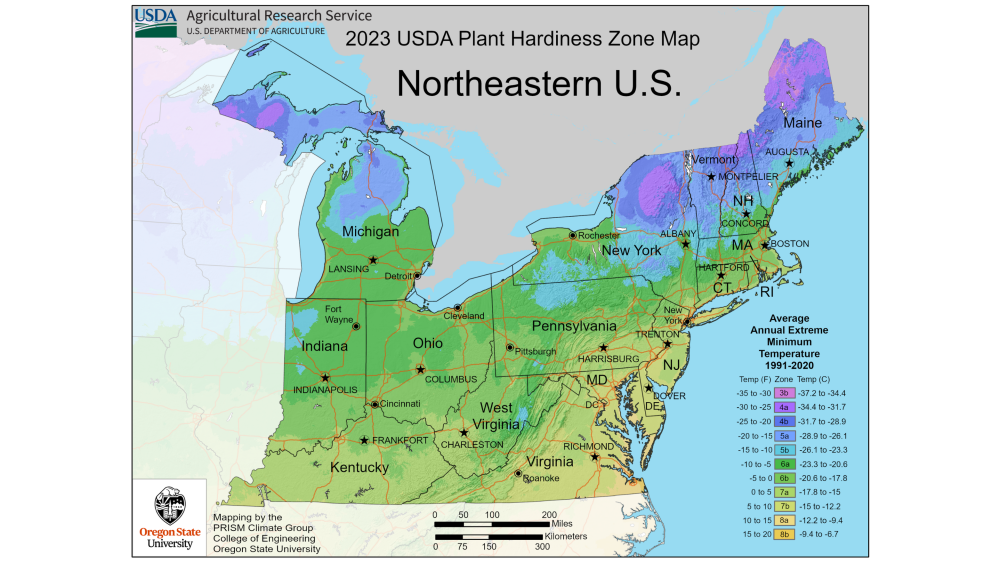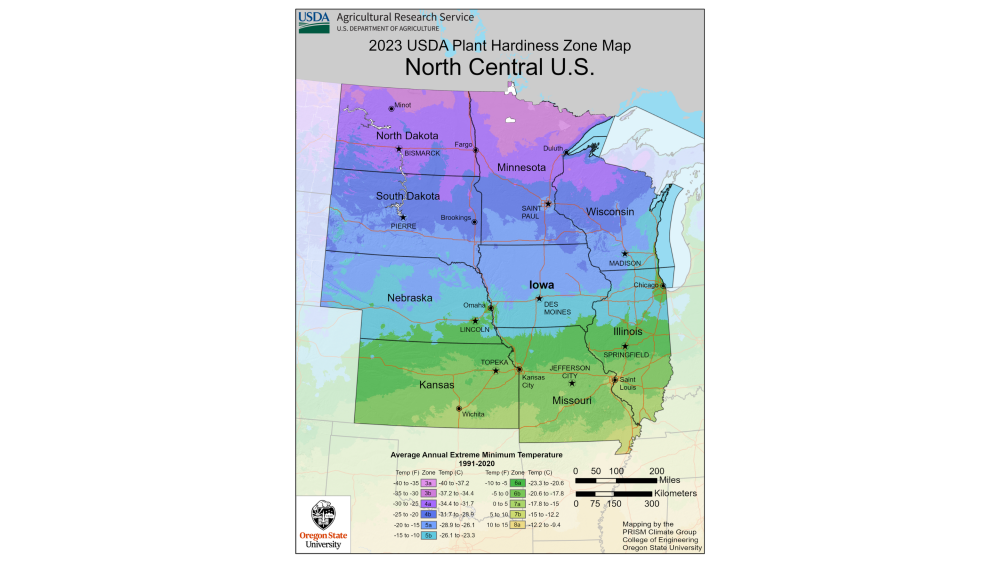Recently, the US Department of Agriculture released an updated Plant Hardiness Zone Map — a resource that gardeners and growers across the country can use to determine which perennial plants can grow in their area. The interactive map was last updated in 2012, so this newest version has been 10+ years in the making.
The map can be utilized by novice gardeners and seasoned farmers alike. Before you dive in, here are some pro tips on how to read + navigate it.
- A location’s zone is determined by its average annual extreme minimum winter temperature.
- On the map, zones range from 1a to 13a, with zone 1a representing -60º to -55º F and zone 13a representing 65º to 70º F.
- The map is interactive, and you can find your exact location’s zone by typing in your zip code.
Some cities may feature multiple plant hardiness zones; we have listed the zone that corresponds with the city center. Recommendations on when to plant are based on a city’s zone. However, this may vary based on the type of plant, geography, weather conditions, and soil temperature.
Northeast
Boston, MA
Plant Hardiness Zone: 7a (0º to 5º F)
When to plant: Mid-April
What native plants to grow:
- Common yarrow
- Wild red columbine
- New England aster
Columbus, OH
Plant Hardiness Zone: 6b (-5º to 0º F)
When to plant: Mid-April
What native plants to grow:
- Black-eyed susan
- Cardinal flower
- Purple coneflower
Indianapolis, IN
Plant Hardiness Zone: 6b (-5º to 0º F)
When to plant: Mid-April
What native plants to grow:
- Purple prairie clover
- Common blue violet
- Wild red columbine
Lexington, KY
Plant Hardiness Zone: 7a (0º to 5º F)
When to plant: Mid-April
What native plants to grow:
- Paw paw
- Purple coneflower
- Common yarrow
Louisville, KY
Plant Hardiness Zone: 7a (0º to 5º F)
When to plant: Mid-April
What native plants to grow:
- Trumpet honeysuckle
- Black-eyed susan
- Wild red columbine
New York City, NY
Plant Hardiness Zone: 7b (5º to 10º F)
When to plant: Mid-April
What native plants to grow:
- Butterfly milkweed
- Nodding onion
- Jewelweed
Richmond, VA
Plant Hardiness Zone: 7b (5º to 10º F)
When to plant: Mid-April
What native plants to grow:
- Common milkweed
- Virginia blue flag iris
- Jack-in-the-pulpit
Southeast
Asheville, NC
Plant Hardiness Zone: 7b (5º to 10º F)
When to plant: Mid-April
What native plants to grow:
- Wild blue indigo
- Foamflower
- Jack-in-the-pulpit
Charleston, SC
Plant Hardiness Zone: 9a (20º to 25º F)
When to plant: Mid-February
What native plants to grow:
- Carolina jessamine
- Trumpet honeysuckle
- Seaside goldenrod
Charlotte, NC
Plant Hardiness Zone: 8a (10º to 15º F)
When to plant: Mid-March
What native plants to grow:
- Flowering dogwood
- Evening primrose
- Purple coneflower
Chattanooga, TN
Plant Hardiness Zone: 8a (10º to 15º F)
When to plant: Mid-March
What native plants to grow:
- Butterfly milkweed
- American hop-hornbeam
- Gray goldenrod
Columbia, SC
Plant Hardiness Zone: 8b (15º to 20º F)
When to plant: Mid-March
What native plants to grow:
- Carolina jessamine
- Wild blue indigo
- Clustered bushmint
Greenville, SC
Plant Hardiness Zone: 8a (10º to 15º F)
When to plant: Mid-March
What native plants to grow:
- Camellia
- Coral honeysuckle
- Wild blue indigo
Lakeland, FL
Plant Hardiness Zone: 10a (30º to 35º F)
When to plant: Mid-January
What native plants to grow:
- Butterfly milkweed
- Trumpet honey suckle
- Carolina jessamine
Nashville, TN
Plant Hardiness Zone: 7b (5º to 10º F)
When to plant: Mid-April
What native plants to grow:
- Butterfly milkweed
- Trumpet honeysuckle
- Wild red columbine
Orlando, FL
Plant Hardiness Zone: 10a (30º to 35º F)
When to plant: Mid-January
What native plants to grow:
- Seaside goldenrod
- Spotted bee balm
- Blazing star
Raleigh, NC
Plant Hardiness Zone: 8a (10º to 15º F)
When to plant: Mid-March
What native plants to grow:
- Carolina jessamine
- Wild blue indigo
- Trumpet honeysuckle
Tampa, FL
Plant Hardiness Zone: 10a (30º to 35º F)
When to plant: Mid-January
What native plants to grow:
- Atamasco lily
- Black-eyed susan
- Trumpet honeysuckle
Winston-Salem, NC
Plant Hardiness Zone: 8a (10º to 15º F)
When to plant: Mid-March
What native plants to grow:
- Swamp milkweed
- White turtlehead
- Woodland sunflower
South Central
Austin, TX
Plant Hardiness Zone: 9a (20º to 25º F)
When to plant: Mid-February
What native plants to grow:
- Texas bluebonnet
- Mexican hat
- Standing cypress
Fort Worth, TX
Plant Hardiness Zone: 8b (15º to 20º F)
When to plant: Mid-March
What native plants to grow:
- Blue sage
- Compass plant
- Purple coneflower
New Orleans, LA
Plant Hardiness Zone: 9b (25º to 30º F)
When to plant: Mid-February
What native plants to grow:
- Aquatic milkweed
- Lemon beebalm
- Purple passion flower
San Antonio, TX
Plant Hardiness Zone: 9a (20º to 25º F)
When to plant: Mid-February
What native plants to grow:
- Texas bluebonnet
- Old man’s beard
- Wild red columbine
North Central
Chicago, IL
Plant Hardiness Zone: 6a (-10º to -5º F)
When to plant: Mid-April
What native plants to grow:
- Bluebell bellflower
- Michigan lily
- White prairie clover
Madison, WI
Plant Hardiness Zone: 5b (-15º to -10º F)
When to plant: Mid-April
What native plants to grow:
- Purple coneflower
- Blazing star
- Black-eyed susan
Minneapolis, MN
Plant Hardiness Zone: 5a (-20º to -15º F)
When to plant: Mid-April
What native plants to grow:
- Bluebell bellflower
- Maximilian sunflower
- Starry false lily of the valley
Kansas City, KS-MO
Plant Hardiness Zone: 6b (-5º to 0º F)
When to plant: Mid-April
What native plants to grow:
- Common blue violet
- Missouri ironweed
- Wild red columbine
Northwest
Bozeman, MT
Plant Hardiness Zone: 5a (-20º to -15º F)
When to plant: Mid-April
What native plants to grow:
- Indian paintbrush
- Showy milkweed
- White sage
Jackson, WY
Plant Hardiness Zone: 4b (-25º to -20º F)
When to plant: Mid-May
What native plants to grow:
- Bluebell bellflower
- Grouseberry
- Thimbleberry
Portland, OR
Plant Hardiness Zone: 9a (20º to 25º F)
When to plant: Mid-February
What native plants to grow:
- Showy milkweed
- Oregon sunshine
- Lady fern
Seattle, WA
Plant Hardiness Zone: 9a (20º to 25º F)
When to plant: Mid-February
What native plants to grow:
- White sage
- White clover
- Common sunflower
Spokane, WA
Plant Hardiness Zone: 7a (0º to 5º F)
When to plant: Mid-April
What native plants to grow:
- Bluebell bellflower
- Golden currant
- Orange honeysuckle
Southwest
Denver, CO
Plant Hardiness Zone: 6a (-10º to -5º F)
When to plant: Mid-April
What native plants to grow:
- Maximilian sunflower
- Mexican hat
- White sage
Las Vegas, NV
Plant Hardiness Zone: 9b (25º to 30º F)
When to plant: Mid-February
What native plants to grow:
- Desert mallow
- Crimson columbine
- Cardinal flower
Sacramento, CA
Plant Hardiness Zone: 9b (25º to 30º F)
When to plant: Mid-February
What native plants to grow:
- Common yarrow
- Valley oak
- California poppy
San Diego, CA
Plant Hardiness Zone: 10b (35º to 40º F)
When to plant: Mid-January
What native plants to grow:
- Scarlet columbine
- Desert mallow
- California lilac
San Jose, CA
Plant Hardiness Zone: 9b (25º to 30º F)
When to plant: Mid-February
What native plants to grow:
- Silver lupine
- Common yarrow
- Bush monkey flower












